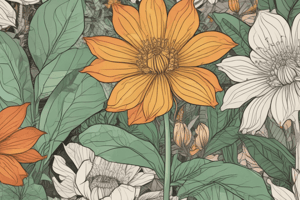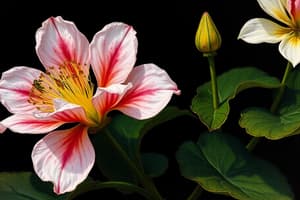Podcast
Questions and Answers
Which structure in a flower is responsible for producing pollen?
Which structure in a flower is responsible for producing pollen?
- Petal
- Stigma
- Anther (correct)
- Ovary
What is a key characteristic of a 'complete' flower?
What is a key characteristic of a 'complete' flower?
- It possesses sepals, petals, pistils, and stamens (correct)
- It contains only male reproductive organs
- It contains only female reproductive organs
- It lacks either sepals or petals
What distinguishes a 'perfect' or 'bisexual' flower from an 'imperfect' or 'unisexual' flower?
What distinguishes a 'perfect' or 'bisexual' flower from an 'imperfect' or 'unisexual' flower?
- The absence of sepals
- The size of the flower
- The color of the petals
- The presence of both male and female reproductive structures in the same flower (correct)
In plant reproduction, what is the role of the gametophyte?
In plant reproduction, what is the role of the gametophyte?
During the development of a male gametophyte, where do pollen grains develop?
During the development of a male gametophyte, where do pollen grains develop?
Which process results in the formation of the embryo sac, the multicellular female gametophyte?
Which process results in the formation of the embryo sac, the multicellular female gametophyte?
In flowering plants, what is the direct product of the fusion between one sperm and the egg?
In flowering plants, what is the direct product of the fusion between one sperm and the egg?
What is the function of the other sperm in double fertilization?
What is the function of the other sperm in double fertilization?
What is the key difference between an ovule and an egg cell in plants?
What is the key difference between an ovule and an egg cell in plants?
After fertilization, what does the ovule develop into?
After fertilization, what does the ovule develop into?
In seed development, what is the role of the cotyledons?
In seed development, what is the role of the cotyledons?
In the context of fruit development, what is the pericarp?
In the context of fruit development, what is the pericarp?
How would you classify a raspberry, blackberry, or strawberry based on its developmental origin?
How would you classify a raspberry, blackberry, or strawberry based on its developmental origin?
How would you classify a pineapple based on its developmental origin?
How would you classify a pineapple based on its developmental origin?
An imperfect flower is observed to have carpels but no stamens. What term best describes this flower?
An imperfect flower is observed to have carpels but no stamens. What term best describes this flower?
A plant species is found to rely heavily on wind for seed dispersal. Which of the following is most likely to be true regarding its fruit development?
A plant species is found to rely heavily on wind for seed dispersal. Which of the following is most likely to be true regarding its fruit development?
Researchers discover a new plant species with unusually large endosperm in its seeds. What can they infer about the plant's seed development?
Researchers discover a new plant species with unusually large endosperm in its seeds. What can they infer about the plant's seed development?
If a mutation occurred in a plant species, preventing the development of integuments within the ovule, what would be the most likely consequence?
If a mutation occurred in a plant species, preventing the development of integuments within the ovule, what would be the most likely consequence?
Flashcards
Plant Reproduction
Plant Reproduction
The process by which plants create new individuals, ensuring the continuation of their species.
Complete Flower
Complete Flower
A flower having sepals, petals, pistils, and stamens.
Incomplete Flower
Incomplete Flower
A flower that is missing one or more of sepals, petals, pistils, and stamens.
Perfect/Bisexual Flower
Perfect/Bisexual Flower
Signup and view all the flashcards
Imperfect/Unisexual Flower
Imperfect/Unisexual Flower
Signup and view all the flashcards
Ovule
Ovule
Signup and view all the flashcards
Egg Cell
Egg Cell
Signup and view all the flashcards
Double Fertilization
Double Fertilization
Signup and view all the flashcards
Pericarp
Pericarp
Signup and view all the flashcards
Simple Fruit
Simple Fruit
Signup and view all the flashcards
Aggregate Fruit
Aggregate Fruit
Signup and view all the flashcards
Multiple Fruit
Multiple Fruit
Signup and view all the flashcards
Accessory Fruit
Accessory Fruit
Signup and view all the flashcards
Study Notes
- Plant Reproduction
Structure of an Idealized Flower
- Stamen is the male part which comprises the anther and filament
- Carpel is the female part made up of the stigma, style, and ovary
- Petals are the colorful parts used to attract pollinators
- Sepal protects the flower bud
- Receptacle attaches the flower to the stem
Types of Flowers Based on Whorls
- Whorls refer to the arrangements of flower parts in a circular pattern
- Complete flowers have all four parts: sepals, petals, pistils, and stamens
- Incomplete flowers are missing one or more of the four integral parts (sepals, petals, pistils, and stamens.)
Types of Flowers Based on Reproductive Whorls
-
Flowers can also be categorized by the presence and arrangement of reproductive structures
-
Perfect/Bisexual flowers have both male and female reproductive structures (androecium and gynoecium) in the same flower
-
Gumamela (Hibiscus) is an example of a perfect/bisexual flower
-
Imperfect/Unisexual flowers lack either male or female reproductive structures
-
Staminate flowers are male, only containing stamens
-
Carpellate/pistillate flowers are female, only containing carpels or pistils
-
Squash, cucumbers, corn, and grasses exemplify imperfect/unisexual flowers
Gametophyte Development
- Gametophyte development refers to the formation and development of the gametophyte stage in the life cycle of plants and some algae
- Gametophytes produce gametes for sexual reproduction
Gametophyte Development Details
-
Male gametophytes (pollen grains) develop within the microsporangia of anthers
-
Each microsporangium has diploid microsporocytes
-
Microsporocytes divide by meiosis, producing four haploid microspores that develop into pollen grains
-
The generative cell divides to form two sperm cells making the pollen grain a mature male gametophyte
-
The nucleus of the tube cell is also a key component of the mature pollen grain
-
Female gametophytes (embryo sacs) develop within the ovule inside the ovary
-
The ovule's megasporangium contains a diploid megasporocyte
-
The megasporocyte divides by meiosis into four haploid cells, but only one survives as the megaspore
-
The megaspore undergoes three mitotic divisions to form the multicellular female gametophyte, or embryo sac
Double Fertilization
- Pollen grain germinates and the pollen tube grows down the style towards the ovary
- The pollen tube discharges two sperm into the female gametophyte inside the ovule
- One sperm fertilizes the egg, forming a zygote
- The other sperm combines with two polar nuclei, forming a triploid cell that develops into the nutritive tissue called endosperm
Ovule vs Egg Cell
- Ovule is a structure that develops into a seed while the egg cell is the female gamete
- Ovule is located inside the ovary , the egg cell is inside the embryo sac within the ovule
- Ovule supports fertilization and turns into a seed whereas the egg cell fuses with sperm to form zygote
- Ovule is multicellular, composed of integuments and the embryo sac while the egg cell is single and haploid
- After fertilization, the ovule becomes a seed and the egg cell becomes an embryo
From Ovule to Seed
- After double fertilization, the ovule develops into a seed
- The ovary develops into a fruit enclosing the seeds
- As the embryo develops from the zygote, the seed stockpiles proteins, oils, and starch depending on the species
- Nutrients are stored in the endosperm
Embryo & Seed Development in Cotton
- The zygote goes through mitosis to form the proembryo and suspensor, which supports the embryo in the endosperm
- The cotton seed has a seed coat and contains the mature ovule within which is the mature embryo
- In the seed, the radicle (embryonic root) is at one end, and the shoot tip at the other end
- Cotyledons form, which are seed leaves that store food. After germination, cotyledons expand and become photosynthetic
From Ovary to Fruit
- While seeds develop from ovules the flower ovary develops into a fruit
- The fruit when mature, aids in dispersal by wind or animals
- Fertilization triggers hormonal changes leading the ovary to transform into a fruit
- If the flower hasn't been pollinated, the fruit usually doesn't develop, and the flower withers and falls away
- During fruit development, the ovary wall becomes the pericarp, the thickened wall of the fruit
Developmental Origin of Fruits
- Simple fruits develop from a single carpel (or several fused carpels) of one flower ex. pea, lemon, peanut
- Aggregate fruits develop from many separate carpels of one flower ex raspberry, blackberry, strawberry
- Multiple fruits develop from many carpels of many flowers forming an inflorescence ex. pineapple, fig
- Accessory fruits develop largely from tissues other than the ovary ex. apple
Studying That Suits You
Use AI to generate personalized quizzes and flashcards to suit your learning preferences.



